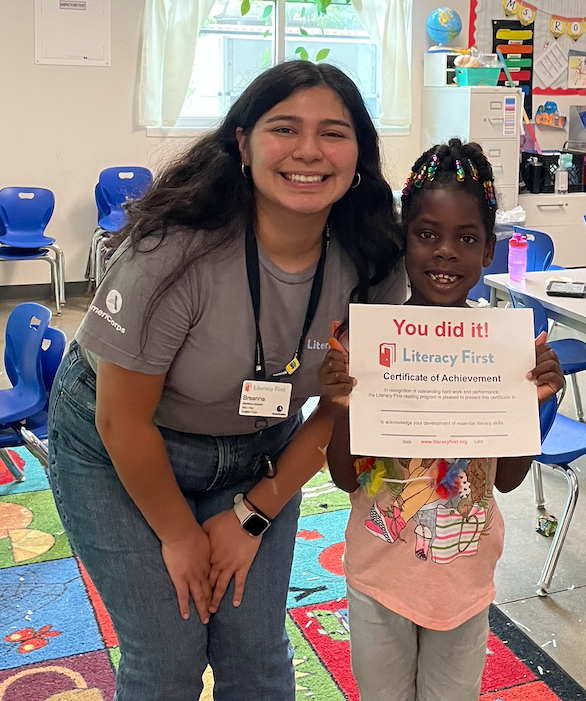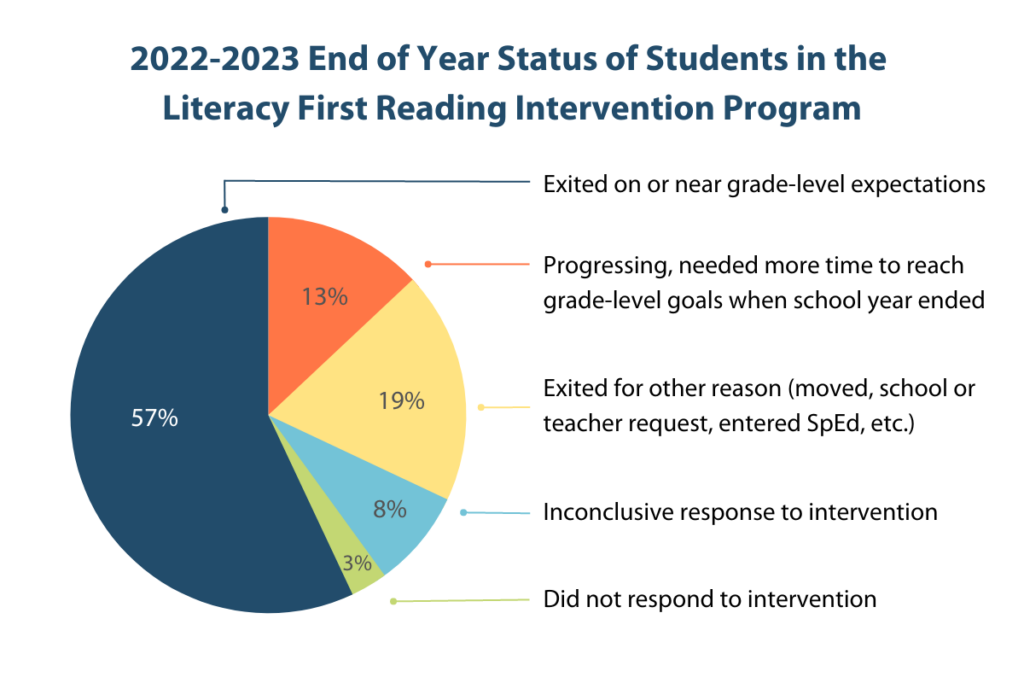As the school year drew to a close this past spring, Literacy First tutors overwhelmingly wished for one thing—more time with the students who were so close to graduating but just needed to stay in the program a little longer. In April, one of our 2022-2023 school year tutors, Breanna, reflected on her experience working with Sara, a sweet student who loved reading. Breanna had the pleasure of watching Sara learn and grow throughout the year. Like around 70% of the students tutored this past year, Sara showed a positive response to the program, developing her reading skills in phonics and fluency. Her progress was a testament to how dedicated she was to learning each and every day. For students like Sara who come close to graduating, our intervention provides the targeted support needed to become more proficient readers.
Student spotlight by Breanna DeLeon, 2022-2023 English Literacy Tutor
Sara is one of my first-grade students. I started reading with her in November, when I first started tutoring. Throughout the year Sara improved so much. We began our lessons in the first level of phonics. Now, in April, we are on the second level of reading fluency. Her progress, I believe, is a direct result of her motivation, her work ethic, and the integrity of the program.
Sara is exactly what her teacher refers to her as—a “sweet girl”. Sara is a quiet, shy student. She does not talk much. You can talk to her about anything and most of the time, she will only respond with a big smile instead of words. Though quiet, she is also an active kid. She likes to dance, skip, and cartwheel down the hall. And while she likes to dance and move, when she reads, she sits very still, sometimes with her legs crossed in the chair, and reads with intense dedication and focus. At the end of every lesson when I drop her off at class, she waves bye to me, walks into her room, turns around, gives me a hug, then runs back into her class.

In the time since I have worked with Sara, I have never repeated asking her to read something. She always reads the first time she is asked, and often begins the next activity of the lesson on her own when she knows the routine. I am amazed at her dedication. Sara was one of my students who was in phonics for a long time, which at times felt repetitive. But for Sara, reading is fun, even if it’s just reading letter sounds aloud. She is so quick to do what is asked, that we flew through the first level of phonics. She was completing two lessons per a single session.
After she completed the first level of phonics, she entered the second level. In March, after seeing her progress, I felt she was ready to begin the reading fluency program. Sure enough, my Literacy First coach confirmed she was ready for the first level of reading fluency. Now, in April, she has started the next level of reading fluency, and is showing great progress. She reads the stories right away and has even started talking to me a little bit about them. The other day, we read a panda story, and she thought the word “bamboo” was interesting, so we talked about bamboo the whole walk back to her classroom.
My only wish for Sara is for me to have more time with her because I am sure that with a little more time, she would be even that much closer to reaching the end of year goals. She began in the program having difficulty sounding out decodable 3-letter words. Now, she is reading stories by herself, talking about pandas in China eating bamboo. I feel very privileged to have tutored a sweet girl like her and see her grow as a reader.
Teaching children to read is complex and requires dedicated time and skilled instruction. But most Literacy First students are able to reach grade-level expectations in less than one year of intensive tutoring. In the 2022-2023 school year, 70% of Literacy First students showed a positive response to our reading intervention, with 57% of students nearing grade-level expectations and another 13% making significant progress. An additional 19% of students did not complete the program due to a variety of reasons like moving schools, excessive absences, entering special education, or beginning to work with a reading specialist. About 8% of students in the program had an inconclusive response to the intervention, meaning that their weekly assessment scores did not show a clear trend. Lastly, 3% of students did not respond well to the intervention. For the students who did not respond to the program, early detection is key in getting them the additional support they need to develop their literacy skills.

Each fall, after undergoing extensive training, our next cohort of tutors begins the year by benchmark testing all students in kindergarten, first, second, and third grades. This is to determine which students in K-2nd will work with Literacy First tutors. We also test 3rd graders so we can keep track of how our former students are doing. Once students are reading on grade-level and graduate from our program, they are likely to continue to thrive in future grades without needing additional support. Some students do need an extra boost of tutoring, and they usually catch up faster the second time they are in the program.
So while Breanna may wish for more time with this sweet student this year, there is still time for Sara to get the support she needs to reach reading proficiency by the end of second grade. If Sara is at a school that Literacy First serves next year, she might just work with another caring tutor who will support her on her reading journey and give her the boost she needs to reach grade-level goals.

